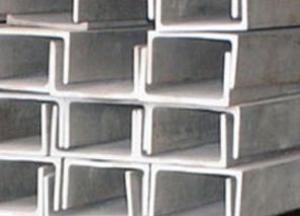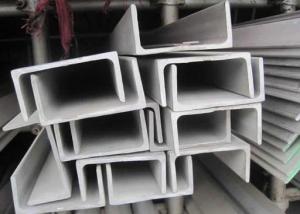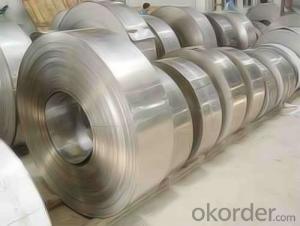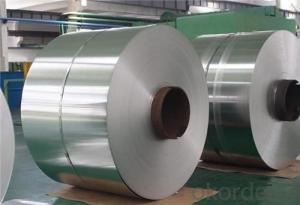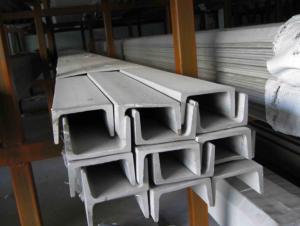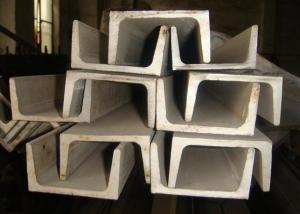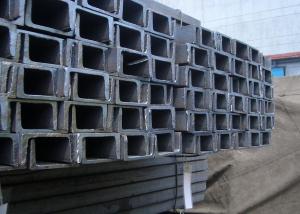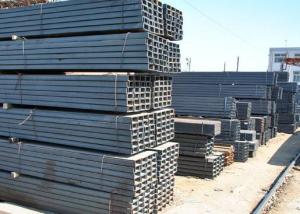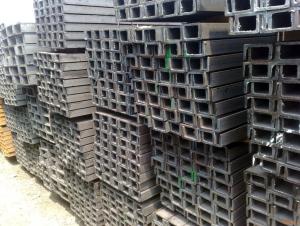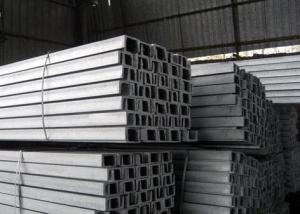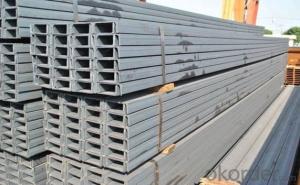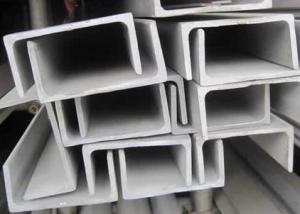Steel Channels
- Loading Port:
- China Main Port
- Payment Terms:
- TT or LC
- Min Order Qty:
- 5 Tons m.t.
- Supply Capability:
- 1000 Tons Per Month m.t./month
OKorder Service Pledge
OKorder Financial Service
You Might Also Like
Stainless Steel Channel
1.Size: 3mm to 24mm Thickness
2.Material:SUS201,202,301,304,304L,316,316L ,321 etc.
3.Length: 4m to 6m,or according to the customer's requirement
4.Standard: AISI,JIS,GB,DIN
5.Finish: Cold Drawn ,hot rolled & Polishing
6.Testing: Each heat number and batch must be tested for both chemical and mechanical properties
7.Application: Produce screw and nut, engine parts, indoor and outdoor decorating etc..
|
Size (mm) |
Thickness (mm) | |||||||||
|
H×B |
3 |
4 |
5 |
6 |
7 |
8 |
9 |
10 |
12 | |
|
Mass (Kg/m) | ||||||||||
|
40×20 |
1.79 |
|
|
|
|
|
|
|
| |
|
50×25 |
2.27 |
|
|
|
|
|
|
|
| |
|
60×30 |
2.74 |
3.56 |
4.37 |
5.12 |
|
|
|
|
| |
|
70×35 |
3.23 |
4.21 |
5.17 |
6.08 |
|
|
|
|
| |
|
80×40 |
3.71 |
4.84 |
5.96 |
7.03 |
|
|
|
|
| |
|
90×45 |
4.25 |
5.55 |
6.83 |
8.05 |
|
|
|
|
| |
|
100×50 |
4.73 |
6.18 |
7.62 |
8.98 |
10.3 |
11.7 |
13 |
41.2 |
| |
|
120×60 |
|
|
9.2 |
10.9 |
12.6 |
14.2 |
|
|
| |
|
130×65 |
|
|
10.1 |
11.9 |
13.8 |
15.5 |
17.3 |
19.1 |
| |
|
140×70 |
|
|
|
12.9 |
14.9 |
16.8 |
18.8 |
20.7 |
| |
|
150×75 |
|
|
|
13.9 |
16 |
18.1 |
20.2 |
22.2 |
26.3 | |
|
160×80 |
|
|
|
14.8 |
17.1 |
19.3 |
21.6 |
23.8 |
28.1 | |
|
180×90 |
|
|
|
16.7 |
19.4 |
22 |
24.5 |
27 |
32 | |
|
200×100 |
|
|
|
18.6 |
21.6 |
24.5 |
27.4 |
30.2 |
35.8 | |
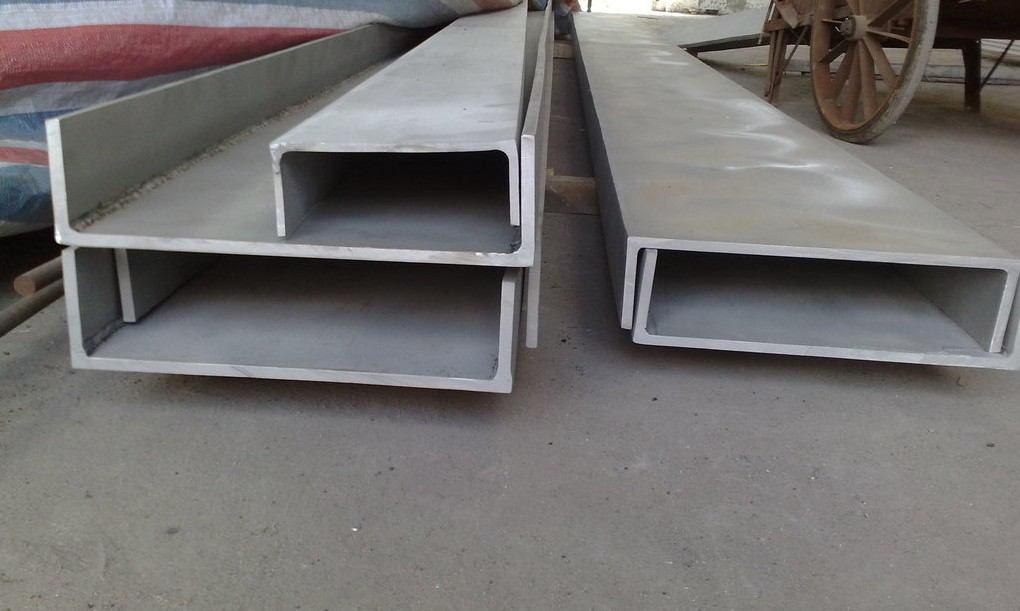

- Q:Is the crane telescopic arm welded by channel steel or by square tube?
- Steel welding steel mostly used as a beam or a column, the steel plate is relatively thick, and the channel has been forming calculation immunity anti disturbance capability is greatly improved, two only in the center position of weld line position, the formation of the moment theory on the bending of the analysis should be small and therefore, whether it is welding crack or welding deformation can better handle. In no case have to supply square, to be.
- Q:How do stainless steel channels contribute to building resilience or durability?
- Stainless steel channels contribute to building resilience and durability due to their inherent properties. Firstly, stainless steel is highly resistant to corrosion, making it ideal for construction projects in harsh environments or areas prone to moisture. This resistance to corrosion ensures that the channels maintain their structural integrity over time, reducing the need for frequent repairs or replacements. Additionally, stainless steel exhibits excellent strength and impact resistance, enabling the channels to withstand heavy loads and adverse conditions without deformation. These qualities make stainless steel channels a reliable and long-lasting choice for enhancing the resilience and durability of buildings.
- Q:Can stainless steel channels be used for decorative purposes?
- Yes, stainless steel channels can be used for decorative purposes. Their sleek and modern appearance, along with their durability and resistance to corrosion, make them a popular choice for decorative applications such as trim, accents, and architectural features.
- Q:Are stainless steel channels suitable for seismic or earthquake-resistant designs?
- Stainless steel channels are indeed an appropriate option for seismic or earthquake-resistant designs. Renowned for its exceptional strength and durability, stainless steel proves to be an outstanding selection for seismic purposes. Its remarkable resistance to corrosion is especially significant in earthquake-prone regions, where buildings are frequently exposed to moisture and environmental factors. Furthermore, stainless steel possesses excellent ductility, enabling it to withstand substantial deformations without fracturing. This attribute is crucial during seismic events, as buildings experience considerable vibrations and motion. By employing stainless steel channels, structural support and stability can be achieved, thereby reducing harm and guaranteeing the structure's safety in the face of earthquakes.
- Q:Can stainless steel channels be used for mezzanine flooring systems?
- Yes, stainless steel channels can be used for mezzanine flooring systems. Stainless steel is a durable and corrosion-resistant material, making it suitable for use in various applications, including mezzanine flooring. Stainless steel channels provide structural support and can withstand heavy loads, making them an ideal choice for mezzanine flooring systems. Additionally, stainless steel has a sleek and modern appearance, which can enhance the aesthetics of the mezzanine space. Overall, stainless steel channels offer strength, durability, and aesthetic appeal, making them a suitable option for mezzanine flooring systems.
- Q:How do stainless steel channels compare to other stainless steel shapes like angles or beams?
- Stainless steel channels, angles, and beams are structural components frequently used in construction and industrial applications. Despite being made from the same material, there are notable distinctions between stainless steel channels and other shapes like angles or beams. To begin with, stainless steel channels possess a distinct shape that differentiates them from angles and beams. Channels are characterized by a C-shaped cross-section with two flanges and a connecting web. This design ensures exceptional structural support and stability, making channels suitable for applications that require strength and load-bearing capabilities. On the other hand, stainless steel angles have an L-shaped cross-section, with two legs meeting at a 90-degree angle. Angles are primarily employed for bracing, reinforcing corners, or constructing frameworks where structural stability is essential. They offer versatility and ease of welding, making them popular in construction and architectural designs. Stainless steel beams, also referred to as I-beams or H-beams, possess a distinctive H-shaped cross-section. These beams find wide usage in construction and heavy-duty applications due to their impressive strength-to-weight ratio. Beams are designed to bear heavy loads and provide structural support over long spans, making them ideal for large-scale projects like bridges, skyscrapers, or industrial structures. The choice between stainless steel channels, angles, or beams for a specific project depends on its requirements and usage. Channels excel at providing support over shorter spans or serving as structural components in machinery and equipment. Angles are commonly used for bracing and framing purposes, while beams are preferred for longer spans and applications with heavy loads. Moreover, the manufacturing process for each shape varies, resulting in differences in production costs and availability. Stainless steel channels are generally easier to produce compared to angles or beams, which may necessitate more intricate fabrication techniques. In conclusion, while stainless steel channels, angles, and beams each offer unique structural benefits, the decision of which to use depends on the project's specific requirements, load-bearing needs, span length, and overall design considerations. Consulting with a structural engineer or stainless steel expert can provide valuable insights and guidance in selecting the most suitable shape for a particular application.
- Q:Are stainless steel channels cost-effective?
- Stainless steel channels are widely recognized as a cost-effective solution in numerous applications. Despite their higher initial cost compared to alternative materials, stainless steel offers long-term value and cost savings. Thanks to their exceptional durability and resistance to corrosion, stainless steel channels require fewer repairs or replacements, resulting in reduced maintenance expenses. Moreover, the longevity of stainless steel ensures lower overall maintenance costs. Furthermore, stainless steel channels boast impressive strength-to-weight ratios, enabling efficient material use and decreasing installation expenses. Additionally, the aesthetic appeal of stainless steel, coupled with its ability to maintain its appearance over time, can enhance the value of projects. Consequently, stainless steel proves to be a cost-effective choice in various industries, including construction, architecture, and manufacturing.
- Q:What are the common sizes of stainless steel channels?
- The common sizes of stainless steel channels vary depending on the specific application and industry. However, there are several standard sizes that are commonly available in the market. In general, stainless steel channels come in different shapes and dimensions, with the most common being the U-shaped channel. The sizes of stainless steel channels typically range from 1 inch (25.4 mm) to 8 inches (203.2 mm) in height, and from 1/2 inch (12.7 mm) to 3 inches (76.2 mm) in width. These channels are available in various thicknesses, usually ranging from 1/8 inch (3.2 mm) to 1/2 inch (12.7 mm), depending on the load-bearing capacity required. Additionally, stainless steel channels may have different lengths, commonly ranging from 20 feet (6.1 meters) to 24 feet (7.3 meters). It is important to note that these sizes are not exhaustive, and custom sizes can be manufactured based on specific requirements. The dimensions of stainless steel channels may also vary based on regional standards and industry specifications. Overall, the common sizes of stainless steel channels provide a wide range of options for various applications such as construction, manufacturing, and structural support.
- Q:What are the options for joining stainless steel channels?
- There are several options for joining stainless steel channels, depending on the specific application and requirements. Some common methods include welding, bolting, and using adhesives. 1. Welding: This is a popular method for joining stainless steel channels as it provides a strong and permanent bond. Different welding techniques can be used, such as TIG (tungsten inert gas) welding or MIG (metal inert gas) welding. Welding requires skilled personnel and specialized equipment, but it ensures a durable and secure connection. 2. Bolting: Another option is to use bolts or screws to connect stainless steel channels. This method allows for easy disassembly and reassembly if needed. It is commonly used in applications where there is a need for frequent adjustments or repairs. 3. Adhesives: Adhesive bonding is a non-invasive method of joining stainless steel channels. Specialized adhesives designed for metal bonding can provide high strength and durability. However, the success of this method depends on factors such as the cleanliness of the surfaces and the compatibility of the adhesive with stainless steel. 4. Mechanical fasteners: Various mechanical fasteners, such as rivets or clips, can be used to join stainless steel channels. These fasteners provide a reliable and secure connection and are often used in applications where disassembly is not a requirement. 5. Interlocking systems: Some stainless steel channels are designed with interlocking systems, allowing them to be easily connected without the need for additional fasteners. These systems provide a seamless and aesthetically pleasing joint, making them suitable for architectural or decorative applications. It is important to consider the specific requirements of the project, such as load-bearing capacity, corrosion resistance, and ease of assembly, when choosing the appropriate method for joining stainless steel channels. Consulting with professionals or experts in the field can help determine the most suitable option for a specific application.
- Q:How do you select the right stainless steel channel for a specific application?
- When selecting the right stainless steel channel for a specific application, there are several factors to consider. Firstly, you need to determine the required dimensions and specifications of the channel. This includes the size, shape, and thickness needed for your specific application. Consider the load-bearing capacity and the overall structural requirements to ensure that the chosen stainless steel channel can withstand the intended use. Next, consider the environmental conditions in which the channel will be used. Stainless steel channels are known for their corrosion resistance, but different grades of stainless steel offer varying levels of resistance to different types of environments. For example, marine applications may require a higher grade of stainless steel with superior resistance to saltwater corrosion. It is also important to consider the aesthetic requirements of your application. Stainless steel channels are available in various finishes, such as polished, brushed, or matte, so choose the one that best fits your desired appearance. Consulting the relevant industry standards and guidelines is crucial in ensuring that you select the appropriate stainless steel channel for your specific application. These standards provide information on material properties, strength, and other technical specifications that can help guide your decision-making process. Additionally, it is advisable to seek guidance from stainless steel suppliers or professionals with expertise in stainless steel applications. They can provide valuable insights and recommendations based on their experience and knowledge. By considering these factors and seeking expert advice, you can select the right stainless steel channel that meets your specific application requirements in terms of dimensions, corrosion resistance, aesthetics, and compliance with industry standards.
1. Manufacturer Overview |
|
|---|---|
| Location | Qingdao,China |
| Year Established | 2008 |
| Annual Output Value | Above US$100 Million |
| Main Markets | Middle East;Europe;North America |
| Company Certifications | ISO9001:2000 |
2. Manufacturer Certificates |
|
|---|---|
| a) Certification Name | |
| Range | |
| Reference | |
| Validity Period | |
3. Manufacturer Capability |
|
|---|---|
| a)Trade Capacity | |
| Nearest Port | Tianjin |
| Export Percentage | 0.8 |
| No.of Employees in Trade Department | 100 People |
| Language Spoken: | English;Chinese |
| b)Factory Information | |
| Factory Size: | Above 60,000 square meters |
| No. of Production Lines | 10 |
| Contract Manufacturing | OEM Service Offered;Design Service Offered |
| Product Price Range | Average |
Send your message to us
Steel Channels
- Loading Port:
- China Main Port
- Payment Terms:
- TT or LC
- Min Order Qty:
- 5 Tons m.t.
- Supply Capability:
- 1000 Tons Per Month m.t./month
OKorder Service Pledge
OKorder Financial Service
Similar products
New products
Hot products
Hot Searches
Related keywords
